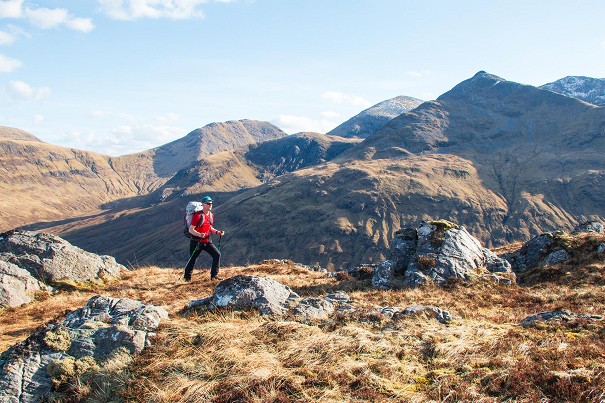
Rab Muon 50L Pack
As a lightweight, midsized backpacking pack, the Muon really stands out for its functional design and its close and comfortable fit. Bring on summer bivvy trips, says Dan Bailey.
In an ideal world you might own a specialised pack for each activity; but with limited budgets and space, many of us will settle for a single do-it-all model for most of our climbing and walking. For year-round mountaineering, hillwalking, overnight walks, or carrying all your gear to a remote crag, packs around the 40 litre mark are a versatile size: Big enough to hold your trad gear and ropes without cramming; able to swallow a full winter rack and all the seasonal trimmings for a day on The Ben; supportive enough to comfortably carry a load of camping gear on a short backpacking mission; yet still compact, trim and well-balanced to climb, scramble or even ski with.
Our last group test of mountain packs in this size range was in 2016, and all the options have changed since then.
We've judged them on: fit and padding; comfort and support when laden; stability when climbing; weight and durability; features; and value for money. None are super-technical lightweights - in this review we're looking for all-round versatility and a degree of toughness. But of course relative lightness is still a virtue, provided a pack also offers enough support when heavily loaded. The ability to reduce weight and bulk by removing features such as the lid and hip belt is also an advantage, since it gives you options.

A note on fit:
The fast-and-light ethos has its limits, and if you're lugging a heavy pile of climbing or camping gear up hills then you want a pack designed for the old fashioned, unglamorous role of load carrier. In this rucksack category a frame or framesheet that offer load carrying support are arguably essential features. But fit is important too, because the hipbelt can only perform its primary function - taking some strain off the shoulders- if the pack is the correct length for your back. The back length on a climbing pack is rarely - if ever - adjustable, but some brands do at least offer the same model in different sizes. We've counted this as a mark in their favour in this review. As with most gear, however, the key message is that it will pay to try before you buy, since the most suitable rucksack is ultimately the one that best fits you.
Which pack wins?
In this selection there are no poor models. Accordingly we have not awarded star ratings in this test; we have however highlighted those that we feel particularly stand out as 4-season all-rounders.
For easy comparison, let's start with the summary table:
| Make and model | |
|---|---|
|
Black Diamond Price: £140 Weight: 1220g Capacity: 40L Pros: Tough, functional, and strippable, this is a great all-round mountain pack Cons: Sweaty in warm weather; there's no neat way to secure spare webbing tails |

|
|
Mountain Equipment Price: £150 Weight: 1165g Capacity: 42L Pros: Durable and functional, and an ideal size for an all-rounder. The supportive back system is good for big loads, but it's still light and trim enough for climbing Cons: No removable hip belt; other packs will be more breathable in warm weather; it's quite 'strappy'; only one back length |

|
|
Lowe Alpine Price: £120 Weight: 1365g Capacity: 35-40L Pros: Tough, well-designed and versatile, the Halcyon is a decent load carrier with all the essential mountain pack features, at a very fair price. Comes in three sizes, too. Cons: Quite heavy; not the coolest and best-ventilated pack for warm weather; no removable lid; the axe attachment system does not work well with all types of tool. |

|
|
deuter Price: £155 Weight: 1478g Capacity: 44+8 L Pros: A comfy load carrier with a robust and supportive back system; loads of room for overnights Cons: A bit big and heavy for more technical climbing; double zipped entry is arguably overkill |
|
|
Gregory Price: £145 Weight: 1030g Capacity: 38L Pros: This is a great lightweight pack for big mountain days, and we've found it very comfy even with heavy loads Cons: Let down as an all-rounder by its less durable fabric and slightly smaller size, while some of the external details are also a bit iffy |
|
|
Arc'teryx Price: £140 Weight: 1244g Capacity: 35 L Pros: Basic, robust and reasonably priced Cons: Sweaty in warm weather; some fiddly features; limited capacity; not ideal for larger users |
|
|
Macpac Price: £140 Weight: 960g Capacity: 40L Pros: Lightweight yet durable, this is a comfy load carrier that comes in two back lengths Cons: Non-absorbent back panel is better in winter than summer; zipped entry has drawbacks versus a conventional lid |
|
|
Montane Price: £140 Weight: 1350g Capacity: 40 L Cons: Chest strap annoying to adjust and feels flimsy; head movement can be restricted by the top of the pack
|
|
|
Salewa Price: £170 Weight: 1252g Capacity: 45L Pros: A versatile and well-designed pack with a summer-friendly vented back system, generous capacity and support for larger loads, and the option to go minimalist Cons: It's expensive compared to rivals, and you're not getting anything extra for that money |

|
|
Mammut Price: £135 Weight: 1005g Capacity: 38L Pros: Lightweight and easily stripped, it's a pleasure to climb with. Well vented for summer use Cons: A bit short for larger users, and capacity is tight for overnights. Minimalist back system provides limited support when heavily loaded |

|
Reviewed by Martin McKenna - Rockfax 
The Speed 40 is part of Black Diamond's mountain-oriented Speed range. This bag is made primarily for Alpine climbing, with low weight and simple functionality at the core of the design. The Speed series includes a range of sizes, from 22 litres, designed for single day excursions, to the 50 litre version aimed at multi-day Alpine climbing. The Speed 40 comes in at 40 litres in its larger size, and closer to 38 litres if you go for the shorter back length. This puts it towards the smaller end of the size range in this review, but we don't think there's much in it, and the Speed 40 is still an ideal middle ground rucksack that's suited to long rock or winter climbs, all-round hillwalking, and lightly equipped overnights.
Weight and Materials
The Speed 40 comes in at 1220g, putting its weight around the middle of the range in this review. For a pack with a good range of features and a hard wearing exterior, this is a respectable weight, but if you want to go lighter it can be reduced to a mere 770g when stripped of its hood, waist belt and frame sheet - minimalist technical climbing pack territory.
The material used on the Speed 40 is predominantly 210D ripstop nylon, aside from at the bottom where a stronger 420D material is used to reflect the additional abrasion this part of the pack will receive. Some models in this test have opted for a lighter weight fabric on lower abrasion areas to further reduce their weight. This of course comes at the potential cost of durability, so if you feel like you want something a bit harder wearing, the Speed 40 may be a good option. After extensive use, we have no issues with its durability.
Fit and Comfort
While the back length is fixed, the Speed 40 comes in two sizes: S/M (torso length 41-48cm) and M/L (47-55cm), and this will be a big advantage over one-size-fits-all packs in helping as many users as possible find a size that really suits. In this test we had the S/M, and with a tester height of 173cm this fits perfectly. If you're around 183cm (6 foot) or more, you will doubtless want to go for M/L.
The overall comfort of the Speed 40 is good although it does seem to be more prone to a sweaty carry than others. The internal frame is a removable plastic sheet, with wire reinforcements to keep it in an ergonomic shape for your back. This also fully prevents climbing equipment like cams sticking into your back. The exterior back padding adds a final layer of cushioning. This material is what seems to be the culprit for sweat buildup, and once you've sweated into the Speed 40, it's pretty soaked for a while. For this reason we'd consider it better used as a winter pack than on sunny summer days.
The hip belt is supportive when fully laden but can also be completely removed if going lightweight. It's also long enough to be clipped around the front of the pack, moving it out of the way when climbing.
The shoulder straps are broad enough at the top to comfortably support a full sack, and narrow off towards the bottom, probably to reduce weight, where less force is put through them. They feature the same padding as both the waist and back, although a bit thinner, and don't suffer from the same degree of sweat buildup, mostly likely because your shoulders are just less sweaty.
Features
This pack has all the essentials for a mountain all-rounder, but not much more - not necessarily a criticism, depending what you're looking for in a pack.
Integrated into the back panel is a small bivvy mat, that might make an unplanned bivvy slightly more comfortable - however this isn't going to replace a roll mat on a planned night out.
The lid pocket is spacious enough for things like ski gloves and goggles, and though the zip isn't water resistant it is at least wide-opening enough to make it easy to slide an OS map in. Under the lid is the usual smaller zipped security pocket, with a key clip.
Either side of the pack are two compression straps, ideal for reducing the volume of the pack if going light or to secure a rope when attaching it on the outside of the pack (there's also a top compression strap for this). All straps come with detachable clip points, so getting your gear on and off is easy. They are easily long enough to hold bulky items like a foam rollmat, but since Black Diamond have provided no way to neatly retain the spare tails of webbing, the Speed 40 is quite a 'strappy' pack.
On the front of the Speed 40 are ice axe attachment points, with clippable straps for the head of the axe and velcro attachment for the shaft. We've not tested these thoroughly in winter, however from our experience Scottish winter conditions can choke up velcro quickly, and we would have preferred a different securing mechanism here. The velcro is at least strong.
Additionally on the front are crampon attachment points, with removable straps to fix them on (supplied).
Our tried-and-true on-route alpine pack, proven everywhere from the Canadian Rockies to the Fitz Roy massif, the Black Diamond Speed is designed for lightweight performance on rock, snow and ice objectives the world over. Fully strippable with a removable waistbelt, lid and framesheet, the Speed is comfortable on the approach and streamlined on the route. Ice tool PickPockets, snag-free crampon straps and a tuck-away rope strap secure gear to the outside, while the drawcord skirt provides easy access and keeps out spindrift and light precip.
Reviewed by Dan Bailey UKH 
The Fang also comes in a 35, and while the smaller version might be our pick for summer climbing and day walks, its 42 litre guise is arguably more versatile, with enough capacity for winter mountains and short overnight backpacking trips. This durable pack has a satisfyingly functional design, with a feature set suited to both climbers and walkers. On a lightweight mission the lid can be removed, while if you're carrying a heavy load then this is one of the more comfortable and supportive models on review. As a no-nonsense mountain all-rounder, the Fang is hard to fault - except that it comes in only one back length.
Weight and materials
At 1165g un-stripped (ME quote 1360g - nice to see a brand being conservative with weight figures), the Fang 42 is one of the lighter packs on review, which is impressive for a solid and supportive all-rounder with lots of useful features and plenty of capacity. One possible weight saving is in the framesheet, which is less substantial than some.
Remove the lid, lid buckles and rope strap, and it weighs 997g. This is more than the stripped weight of some rivals, but in the scheme of things it isn't really that far off the weight of a minimalist alpine pack such as the Tupilak 37, unless you're counting every gram.
With thick, durable ripstop 'M-Series' polyamide fabric - M210 on the main body and an extra-burly M840 on the base - this pack really feels like it's made to last, and after several months of use we have yet to put a mark on it. The fabric has a water-repellent coating, so while the pack itself is not waterproof (very few are) it easily shrugs off snow and light rain. Its mix of plastic and metal components all feel high quality; webbing straps are narrow to save a bit of weight; and all seams and stitching feel tough. In short, the Fang is a reliable mountain workhorse at a weight that won't break the bank.
Fit and comfort
A unisex model that comes in just one size, the Fang will either fit you, or it won't. I am 183cm/6 foot, with quite a long body, and typically find one-size-fits-all day packs a bit short; but even for me the Fang 42's back length is generous enough to allow the hip belt to do the job it was designed for, which is rare. It's likely that smaller users may find the pack a bit long, but since they are well catered for by most other models it's probably fair that we make a virtue of the Fang's length.
Weighed with a rack and rope, or a pile of camping gear, the Fang proves a sturdy and supportive load carrier, and we've used it very happily for an overnight mini-backpacking route - not something that all the packs on review here would be equally good for:
But though you can carry heavy loads in it this pack also feels well balanced and un-restrictive when climbing, and in that sense it's the best of both worlds. Instead of the more traditional metal struts, there's a moulded plastic panel inside. Covering the entire area of the back to give you a good balance of firmness and springiness, this panel also protects the wearer from jabby pack contents - but if you want a lighter, softer feel, the plastic sheet is easily removed. In terms of ultimate longevity I'm not convinced that this plastic sheet is going to outlast the more traditional aluminium struts, but I've had no cause to worry about this so far.
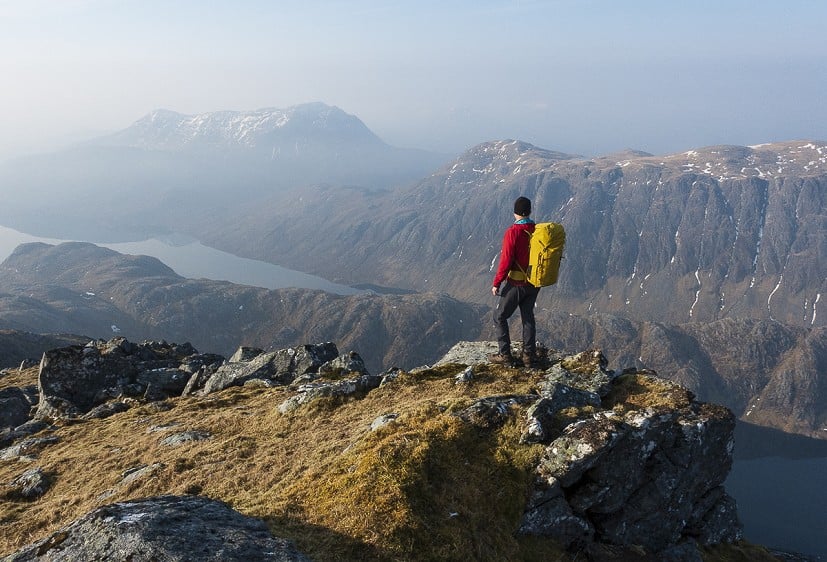
Padding on the back panel, hip belt and shoulder straps is firm but forgiving, helping with the overall feel of support and comfort when carrying heavy loads. The belt and straps are well sculpted for a form-hugging fit without limiting arm movement, and though there is no attempt to add ventilation, we've used the Fang in warm spring weather without feeling unbearably sweaty. However the more open mesh found on some other models is clearly better for summer use. While the hip belt does a good job of taking some of the weight, its cushioning is quite deep, and when you're climbing it doesn't fold as neatly around the pack as a softer belt would. Unfortunately, it's not removable.
Features
Entry to the pack is via a conventional lid and double drawcord. The wide mouth of the pack gives easy access, and the two drawcords are smooth-running. For extra capacity (that's the '+' bit of 42+) the lid can be raised, while if you want to go stripped back and simplified it's removable, leaving the drawcord closure and over-the-top rope strap (also removable). For wet weather use the pack in this configuration might let in a bit of rain, but the drawcord can certainly be scrunched down tight enough to keep out most winter spindrift.
One slight niggle is that when you take off the pack and go to put it back on, still jthe rim of the lid readily snags on the top shoulder adjustment buckles, so you often end up having to re-tweak the tension here. And since it involves un-threading the top rope strap, stripping off the lid is a bit more of a fiddle than designs that simply unclip. It's nice to have the option of no lid, particularly if you're rock climbing, but for general mountain use we think most users will leave it fitted most of the time.
For all the loose bits and bobs you want to hand (gloves, sunglasses etc) the lid itself has a fantastic deep pocket, which holds a lot more than most. With a wide zip-round entry, and two zippers, it's easy to get at items like your map; the only downside is that the zip is not weather resistant. On the underside is a small zipped valuables pocket with the essential key clip; unfortunately there is no zipped pocket in the main body of the pack, for when you're going lid-free.
Should you want to hold something bulky on the sides of the pack - a tent, say, or a rope - then the two compression straps are long enough to allow you to do so without a struggle, while the top two also have a clip for easier use. You get side sleeves, too, which are useful for securing things like walking poles or baguettes, without them slipping through the straps and getting lost. These ones are part made of that very tough rucksack fabric, and partly of elastic, so they'll just about stretch to fit a 1 litre bottle. If clipping on extra items, such as a helmet, the Fang has two robust daisychains, and these can be threaded with a length of shock cord (supplied) to give you even more external carrying options. For winter use, the axe holding system is simple, secure, and easily used wearing gloves.
The Fang is compatible with a water bladder, and it has a little haul loop. What other features would you really need in a mountain pack? Nothing that we can think of.
Any more quibbles? If we're being picky (it's our job), this is quite a 'strappy' rucksack, and it might have been nice to see little elastic loops sewn in to some of the webbing, just to neaten up the loose tails. One final point worth mentioning is ethical rather than practical: Mountain Equipment have signed up to the Fair Wear Foundation, an initiative working to achieve fair working conditions worldwide.
A tough, versatile and strippable pack, the largest of our Fang series is ideally suited to year round mountaineering and more remote climbing and ski trips.
Reviewed by TobyA 
The Lowe Alpine Halcyon 35:40 is a great pack, with a tough feel and thoughtful design that makes it really multi-functional. Ideal for the alps or UK winter climbing, it also works well as a hill walking pack or even for short backpacking trips - though for that role it's worth noting that it's at the smaller end of the range in this review. If the 35:40 seems a bit tight for multi day mountaineering or backpacking, the Halcyon also comes in a 45:50 version. This is far from the lightest pack in its class, but if you feel you don't need so much support in the back system then its weight can be significantly reduced by removing the frame and back sheet. The price represents excellent value for money, too, and we're not sure you are getting much less with the Halcyon compared to its more expensive peers.
Weight and materials
At a total weight of 1365g for the medium size that I have reviewed (size Large is a bit heavier at 1.46kg), the Halcyon 35:40 is no featherweight, but it has a back system that allows you to lug around relatively heavy loads while still being clearly designed for climbing in terms of things like the cut of the shoulder straps. And if you are willing to go without the wire frame and stiffener-sheet in the back, plus remove the padding from the hipbelt, the Halcyon's weight drops to below a kilo - which is far closer to what many will consider "lightweight" for a pack of its size. Stripped except for the webbing waist strap, it weighs 991g, while its fully stripped weight is down to 947g.
The side and base is one piece of a textured cordura-like fabric, which is very tough - the Halcyon has had a lot of use now, and I've failed to make a mark on it. The rest of the pack and lid is made out of a ripstop nylon with a slightly rubbery feel to it. Rain and snow are shed from this like off the proverbial duck's back, and it seems almost as tough as the base. Overall the materials seem very high quality, and so too the build. I suspect this pack will last decades rather than just years.
Fit and comfort
While no female fit is available, this pack does come in three different back lengths, which is an advance on the one-size-doesn't-fit-all approach taken by most of the models on review here. Small has a 43cm back length; Medium is 48cm; and Large is 53cm. At 175cm tall the Medium fits me well, allowing the hip belt to sit in the correct position to take some of the strain.
With its removable frame sheet and sprung steel frame, the Halcyon is a good load carrier, offering decent support with heavier weights - something you'll appreciate whether you're winter mountaineering or simply carrying a load of gear to a summer crag. The padding is comfy without being too deep, and the shoulder straps nicely contoured to allow for free arm movement when climbing or scrambling. The moulded back panel is designed to shed snow, which is an advantage on the winter mountains, but it's not the best ventilated in warmer weather, and you can certainly find cooler packs for summer use.
If climbing or scrambling in the pack with the waist belt done up and wearing a helmet, I have found that when looking directly up the back of my helmet can bump into the top of the frame. This isn't a massive problem, and may partly depend on the fit on me personally, but one solution is to remove the wire frame while leaving the frame sheet in. Having done this with various similar packs down the years, I've found this also makes them less obtrusive once they are nearly empty and you're climbing with the pack on.
Features
The Halcyon is a classic, single point of closure, top-entry mountaineering pack. Unlike the fashion among many modern alpine packs it has a non-removable lid with a good sized pocket and a slimmer security pocket on the inside. The lid closes with a hook arrangement that Lowe Alpine call a LoadLocker. This works easily even with thick snow-covered gloves on, and is essentially unbreakable. Though you can't remove the lid, I've found it folds pretty neatly inside the pack, which could be useful when climbing and gives the Halcyon the look of a fancy lidless technical pack.
There are two compression straps on each side; the top ones can be quickly undone with a buckle. These straps work with the separate wide and padded ski slots just below the lower compression strap to carry most skis in an A-frame configuration. The reinforced ski slot takes the majority of the weight by catching the heel section of the binding, on both pin and frame skimo bindings. Occasionally this system is a little less effective with telemark and touring bindings that have no - or minimalist - heel pieces, but normally these skis will happily stay in place if the upper compression strap is tightened below the toe section of those bindings.
Another notable feature of the Halcyon's design is the chunky YKK zip down the side of the main body of the pack, which allows easy access to your gear wherever it has ended up inside. Though side zips are not universally loved (they might fail, or leak, or be left open by mistake) they do have their fans - and I like them at the crag, when the big side entry can be really handy.
There are lots of other clever little design features on the pack which show the thought that has gone into it: a whistle on the chest strap (actually detachable and not part of the buckle like on lots of other designs); a rope-holding strap under the lid which also squashes down the extendable part of the lid; mountain rescue instructions printed under the lid; tiny loops sewn in with the compression strap that easily allow you to add some tubular elastic should you want to carry something bulky like a foam mat on the outside of the pack, if backpacking or alpine climbing.
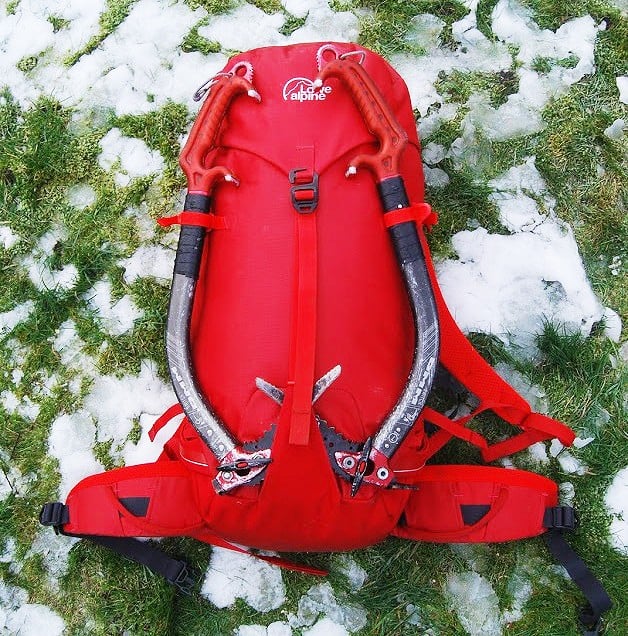
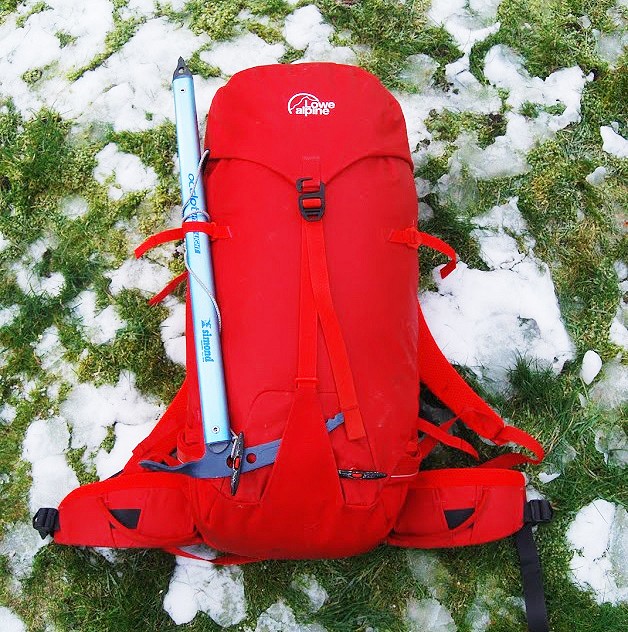
One feature is problematic though: how it carries ice tools. The "HeadLocker" tool attachment points at the bottom work fine, but because the upper attachment points rely on the side compression straps and are not located directly above the head lockers, they make the shaft of the tool go diagonally, not straight up. The longer your ice axe is, and the straighter, the more pronounced this is. I haven't impaled myself or anyone else on the spike of the ice axe whilst swinging the pack up onto my back, but somehow this arrangement feels like it makes this more likely. With modern curved tools the system works fine, and these kinds of ice tools might have been what the designers had in mind originally, but with a longer straight-shafted walking axe it really doesn't look right at all. This is a bit annoying if you're out for a winter walking day.
Whether you're scaling glaciers or projecting a summer rock route, the Halcyon 35:40 alpine mountaineering pack has everything you need for a day moving in the mountains. Born from Lowe Alpine's vertical heritage, the Halcyon 35:40 is a mid-volume, traditional mountaineering pack designed for the extraordinary. With features including a rope compression system, pick retainer panel and reinforced ski slots, you can carry your kit securely over rock, snow or ice. An extendable lid increases the volume by 5 litres, while a stiffened weather flap/compression system aids stability. A lid pocket and zipped side entry keeps kit organised and accessible.
Reviewed by Dan Bailey UKH 
The biggest model in Deuter's Guide range, this is a solid all-round mountain pack that's equally at home on hill walks, scrambles and winter climbs, and easily spacious enough for a couple of days backpacking. With its generous cushioning and substantial frame, the Guide 44+ feels more like a small trekking pack with some climbing capability than a minimalist model for harder climbs, but while it's no lightweight this is a durable and supportive pack, and arguably the best model on review for regular backpacking use.
If you're looking for a reliable work horse with high levels of comfort, and a larger capacity, then this could be it; if you want smaller or lighter, then in Deuter's own range there's the Guide 34+ (32+ for women) or the Guide Lite in various sizes:
I reviewed the Guide 44+ in spring 2020, and the only change since then has been Deuter's logo. Everything I said then still applies, but it's worth looking at afresh in the context of this group test.
Weight and materials
Deuter's quoted weight is 1450g, while we make it 1478g; either way, the Guide 44+ is the heaviest pack on test here; however it's also one of the larger, more supportive, and more durable models, so its comparative heft seems fair enough. While the lid can't be removed, with the hip belt pad stripped off the pack weight goes down to 1268g. Thanks to its comfy fit, I can't say I've noticed its weight when walking, though for harder climbing it's an obvious consideration.
With the main body in a robust 330D ripstop nylon, and a base in 600D polyester, the Guide feels good and tough, and Deuter's build quality always seems to be among the best. Having used last year's pack for a lot of hillwalking and winter mountaineering, I can say with confidence that it's made to last.
Fit and comfort
With a robust internal frame, the Guide 44+ provides a serious level of load carrying support for a pack of this size and remit. I've used less supportive trekking packs! However, because the frame is narrow and V-shaped, it doesn't feel bulky or restrictive on the back. If you prefer a softer and marginally lighter bag, the two aluminium stays could be removed.
Cushioning is more generous than some, especially on the lumbar pad and hip belt, but you do also get an air gap in the small of the back, which isn't always the case on a climbing pack. Where it contacts the body the padding is very breathable, with an airy mesh that helps make the Guide 44+ one of the more comfortable packs for use in hot weather. The harness is nicely sculpted for free arm movement when climbing or scrambling, and the sternum clip slides up and down a rail for easy height adjustment on the go.

If it fits you, a lot of additional load carrying support will be provided by the hip belt. Thickly padded and very broad, this uses Deuter's VariFlex system, pivoting to move with your body. While this would come in handy if you were using the Guide 44+ as a trekking pack, or lugging a rope and rack to a distant mountain crag, I think it's overkill for day walks, and a belt this big just gets in the way if you're on any kind of technical terrain.
The Guide 44+ comes in just the one size, with a fixed back length that will not suit all users; for smaller people, the Guide 42+ SL has a shorter back length. Despite Deuter being German (a nation not known for being small), it's taller folk that are less likely to fit the Guide series. At 1.83m/6 foot, I am at the upper end of the range on the 44+, and the fins of the hip belt sit significantly above my hips. On me this renders the belt more or less redundant as an aid to load carrying, so I generally remove the belt pad (it's easily done) to leave just a webbing strap. This is still useful to stop a heavy pack sliding around on my back, but if I don't want it (when climbing, for instance) the strap closes neatly around the front of the pack - something you can't really do with the padding fitted.
Features
No minimalist, the Guide 44+ will appeal to those who like plenty of features. The floating lid can be raised a long way to add up to 8 litres of extra capacity - good if you're carrying overnight gear. It cannot, however, be removed altogether, so there's a limit to how 'strip-able' the Guide is. One drawback of the 44 litre size is that if you're only part-loaded (when you've reached the climb and half your gear is now hanging off your harness, for instance) the lid cannot be pulled as far down as you might like, to compress the top of the pack, since the buckle straps are attached quite high. Any pack of a given size is going to be sub-optimal when you only use half its capacity, but since it's not as easy as some models to neatly squeeze it down, the Guide 44 isn't as versatile for less gear-intensive uses, such as summer day walks. On the other hand if you're carrying a lot then it's all good!
For bits and bobs, the over-lid pocket is pretty roomy, and sensibly features a water resistant zip (an advance on a lot of models in this review); the opening is a bit tight to comfortably fit an OS size map though, which is sometimes a pain. There's lots of space in the zipped under-lid pocket; for added security this would arguably have been a better place for the key clip. Beneath the lid you get a conventional double-drawstring closure, and a removable rope strap.
A small stretch mesh zipped pocket is provided on one side of the hip belt, enough for some sweeties if not much else. On the other side there's a little gear loop and a retainer for an ice screw clip, which is unlikely to be wanted when climbing but may be handy when plodding over a glacier, when you want the hip belt done up for comfort but also need access to some hardware in case.
Inside, the lower third of the pack can be isolated with a zipped divider to make a separate compartment, which is accessed via a zip right around the bottom of the pack. While some users will appreciate this trekking pack-like ability to access stuff without opening the lid, others (myself included) would rarely if ever use a lower zipped entry on a rucksack of this size, and may consider the zip to come with drawbacks (weight, potential failure, leaving it open and losing things) and no great benefit. A second big zip is provided on the side; zip fans will rejoice, while zip sceptics will consider this one doubly redundant. Though the product spec mentions auto-locking zips, they really aren't, and could easily be nudged open.
While this is already a roomy model, there's plenty of external storage too, with a double row of daisychains to clip stuff to, and the addition of a little stretchy helmet holder thing (is this really preferable to just clipping the helmet on via its own strap?). The twin axe attachment points are commendably neat and simple to use with gloves, and don't try to get fancy.
On each side is a pair of compression straps, the top ones with a clip for easier use when attaching things, and the bottom two reinforced for carrying skis. While the side straps on some models are too short to hold bulky items like rollmats, Deuter have provided really generous tails here; and when not needed, that extra length can be rolled up and neatly secured using sewn-in velcro retainers. The same is true of the main pack closure straps. It's good to be able to roll the excess webbing away, and helps make the Guide a neater and less 'strappy' pack than it could have been.
There is a water bladder sleeve, and a tough haul loop. You also get some basic what-to-do-in-an-emergency info, which if nothing else gives you something to read on a long cold bivvy.
Our mountaineering expert is now even more experienced, slim and lightweight. The well-designed alpine backpack guarantees absolute robustness, a snug fit and maximum control on demanding tours.
Reviewed by Martin McKenna - Rockfax 
The Alpinisto LT 38 is explicitly sold as a minimalist model, and has slightly less capacity than the average in this review. This simple yet functional pack is a decent enough choice for anyone looking for one model to do it all, but it does err on the side of lightness rather than having loads of features. It's ideal for anything from hillwalking, to technical climbing and skiing, but perhaps just a bit of a stretch if you're out overnight with a tent. The Alpinisto LT also comes in a smaller 28 litre version. Although this was not on review, this could be good for anyone who wants the features of the Alpinisto LT, but without the bigger pack size. Those who like the basic idea but want a more solid and traditional alpine pack could also look at the Alpinisto model, which comes in 35 or 50 and weighs a lot more.
The Alpinisto LT is a very respectable 1030g (size Small/Med) with everything attached, which is very light for an all-round mountain pack with a full compliment of features. This can be reduced to a properly minimalist stripped-down weight of just 630g by removing the lid and back panel. This of course compromises a bit of comfort, without as much back padding and load carrying support.
Accounting for its lightness, the main body is constructed of 100D & 210D high density nylon, a fair bit thinner than the materials used in some of the beefier packs on review. The bottom panel is double layered, as this area will receive the most wear. Around the top and sides of the pack the thinner 100D nylon has been used to reduce weight in areas that may not receive as much abrasion. In general the pack feels robust enough, although if it's getting dragged up thrutchy winter chimneys regularly, it will inevitably wear quicker than some. This is no knock-about workhorse, but more of a lightweight thoroughbred - and that entails treating it with a bit more care. Due to some of the lighter materials this bag uses, we'd definitely keep crampons on the outside, for instance.
The Alpinisto LT is available in two back lengths, S/M and M/L, and this is a big advantage over models that only come in one size, extending the range of potential users that it'll properly fit. At 176cm/5ft8 tall I have been using the smaller size, and find the hip belt sits about right on me, to take some of the weight as it should. Officially S/M has a torso range of 40.6-45.7cm, while M/L fits back lengths between 45.7-55.9cm (Gregory's American habit of using inches doesn't translate that well to metric!). We think back lengths are a bit of an inexact science, but that does at least give you some idea of the model's size range.
Comfort is an area where the Alpinisto LT really shines. I've found it a fantastically comfortable bag, even with a good amount of weight in it. Inside is a framesheet and thermoformed back panel that keeps the pack in shape, providing a decent level of support when fully laden. This also offers some insulation in winter, and of course decent padding for your back. Integrated to the back of the pack is thin foam cushioning that gives great comfort considering its weight. This moulds well to your back, helping to evenly distribute the load.
Although the Alpinisto is comfortable it does suffer a bit from sweat buildup. Its flatter back means there isn't much room for air to circulate as almost all the pack is in contact with the user. The material is somewhat breathable, but on a hot day there are definitely better options.
The hip belt padding and shoulder straps also feature the same material and again these are comfortable and don't dig in. The hip belt pads can be adjusted to slide forward and back so can be placed in different positions depending on where it is comfortable for the user. Optionally, these can be taken off completely if you have a lighter pack and don't need the support from your hips.
The usual adjustments you'd expect from a premium rucksack are present, allowing you to get the load close to your back and over your hips.
Although the Alpinisto LT is a minimalist bag, it does have some small features that tuck away or can be removed. For the winter climbers, the bag has two ice axe attachments that tuck away into small flaps located on the front of the pack. The picks when stored slide nicely into an integrated flap, however the shaft attachment point is not the best; being part of the bungee cord from the front of the pack, it requires the side compression straps to be undone in order to attach. This would be fiddly and annoying out on a cold windy mountainside.
Crampons can easily be stored on the outside of the sack on the elasticated front bungee attachment and then further secured with the lid strap.
The hood features a large top pocket and a smaller under lid pocket. I often remove the lids of my packs these days and I was glad to find a small internal pocket within the main compartment, perfect for car keys if you do decide to strip the pack down.
The compression straps at either side are strong and unlike some packs, feature clips, which makes rope and ski attachment far easier than having to slide them in then compress. However, these straps are a bit short for attaching bulkier items, which is a rather obvious mistake for the designers to have made. At the very bottom of each side are reinforced ski loops, which are great and really take the brunt of the weight off the lighter compression straps. This allows for an A-Frame ski carry.
Lastly, an internal pocket allows for a bladder to be placed inside and secured using a buckle hanger at the top of the sleeve. A small opening allows for a tube to run out and clip to your shoulder strap. This is at the top and center so can easily be placed on either side.
A minimalist approach pack, or a streamlined ascent pack, the Alpinisto 38 LT has enough space for long days, with the configurability to match the task at hand. Lightweight materials and durable aluminum hardware give you confidence to move fast in the Alpine.
Reviewed by Dan Bailey UKH 
In terms of technical packs, the best known offerings from Arc'teryx are probably the minimalist, stripped-down Alpha FL series. But here's something more conventional, a lidded model that offers a bit more versatility for all-round use, making it equally applicable to alpine/winter climbing, summer mountain rock, and hillwalking. While there's nothing groundbreaking about the Alpha AR35, it is solid and functional, and offers all the essential features you'd want in a pack that's designed as a generalist. At just 35 litres it has only just scraped into this c.40 litre review, and this is as small as many users will want to go for winter climbing days or one-night backpacking trips. We feel a 40 litre version would have made a better all-rounder.
Weight and materials
At 1244g on our kitchen scales for a size Reg (Arc'teryx say 1.17kg for the smaller size) the all-in weight of the AR35 seems reasonably fair for a pack that's built sturdy, though it's worth noting that some models of a similar design (for instance the ME Fang 42+) manage to be both lighter and larger. Remove the lid and the pack weight goes down to 1130g - still not that impressive. Taking out the back plate loses you another 334g, though you're then left with a floppy and unsupportive pack, which at this sort of size isn't much cop for load carrying.
It's made of high tenacity nylon, into which Arc'teryx say that a "liquid crystal polymer ripstop grid is incorporated" in order to prioritise abrasion and tear resistance. I don't pretend to know anything about the science, or if this is as high tech as it sounds, but the Alpha AR 35 is definitely made of tough stuff, and shows no sign of wear after about 12 months use (including plenty in winter). Build quality is also high, and this is very much a pack for rough treatment in the mountains. The fabric readily shrugs off rain and snow, so although this isn't a waterproof seam-taped pack such as the Alpha FL, it's certainly good for a fair bit of weather.
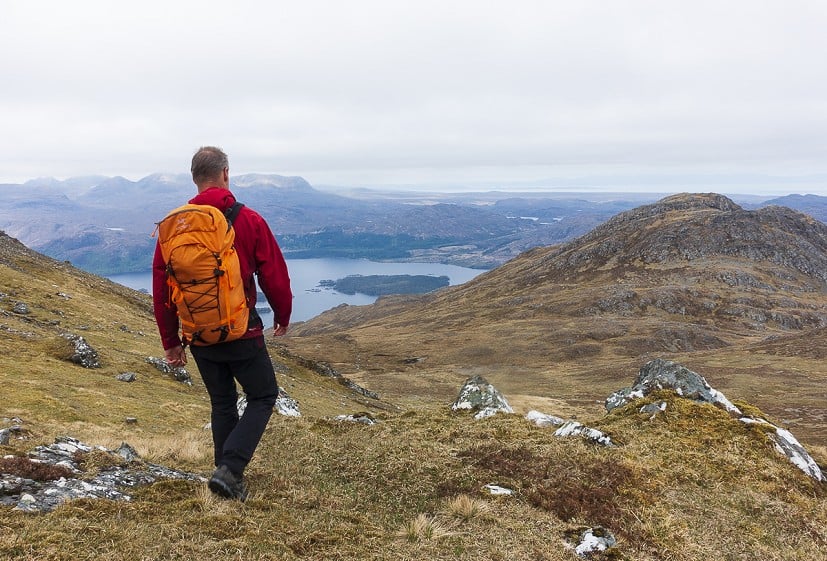
Fit and comfort
The Alpha AR35 is a unisex model. Though it's available in two sizes, which is an advance on some models on review, it's really built for small-to-medium frames, not taller users. Short is for a back length of 42.5 - 47.5cm, while Regular fits backs of 46.5 - 51.5cm. I've been using a Regular, and at 1.83m tall and with a fairly long back (I'm not convinced it's possible to measure your back accurately, so I've never tried) the pack just about works on me, though the hip belt sits at least a couple of centimetres too high to do much load carrying; anyone much taller than about 6 foot is going to want to try this on for size quite carefully. While Arc'teryx do offer some gender-specific packs in a Tall version, this oddly isn't the case with their unisex models.
With a sturdy plastic framesheet (removable) reinforced with a single aluminium stay, there's plenty of back support, and it it fits you then the Alpha AR35 should prove a decent load carrier. At the same time it feels snug and well-balanced when climbing. Cushioning on the back is provided by a foam pad (also removable - though you wouldn't), while on the shoulder straps there's quite a depth of padding. I'm not a big fan of deep padding, particularly on a climbing pack, and I do find it a bit obtrusive here when raising my arms to climb. Something about the way the top of the straps are attached to the pack also feels odd on me, and over a long day with a reasonable weight I sometimes notice they're digging in at the shoulder blades. Being a bit small for me the pack does sit quite low, so perhaps a shorter wearer won't have this issue. The sternum clip is adjustable for height, but larger users may find that it's not possible to set it low enough on the shoulder straps. It sits a bit too high on me.
On the hip belt the cushioning is a lot thinner, which makes for a lower profile and more form-hugging fit. While the belt isn't removable, this thin padding allows it to be doubled around the pack when you're climbing, to keep it away from your waist. However the padding does seem to be degrading at the point where the belt folds.
No attempt at ventilation has been made. Against your back it's the same high tenacity nylon as elsewhere, while the harness and hipbelt are entirely non-breathable. Although they don't absorb loose snow, they're equally impermeable to air and sweat, so while this rucksack is well suited to winter it should come as no surprise that I've found it quickly gets clammy in warmer conditions, and this slightly undermines it as a year-round contender.
Features
Instead of using conventional fastex plastic buckles to secure the lid, Arct'eryx have gone with a system of their own, which closes via a loop that has to be fitted into a plastic 'hook'. It's the same on the rope retaining strap, and while it works better with this single strap, it's a fiddle to use the lid hooks - especially when wearing gloves, with cold hands. This seems a bit like reinventing the wheel, but coming up with something oval-shaped. For more of a minimalist feel the lid can be removed, or if you're over-stuffing the pack then it's adjustable to various heights via a pair of little metal hooks and sewn loops. Again, this doesn't seem to be any advance on the traditional webbing and ladder lock buckle.
For all the loose items you want to keep in reach, the top lid pocket is pretty roomy, though annoyingly not wide enough to fit an OS map. Arc'teryx have provided a water resistant zip here, which is not 100% waterproof but clearly an advance on most of the packs in the review. You get a decent sized under-lid pocket too, but it's odd that they've located the essential key clip in the external pocket since keys usually aren't something that need to be accessed during the day. Inside the main body of the rucksack is a third small zipped pocket, which is where your small essentials would go if you were going lid-free. This addition makes sense, though I do find it gets in the way of a water hose.
Remove the lid and you have a secure double drawcord closure, plus the aforementioned rope strap; unfortunately this feature is a bit short to hold a bulky rope if you have already filled the pack right up to capacity. As per its traditional look, there are twin side compression straps. These have enough length to hold bulky items like a foam mat, and they fasten with buckles for convenience, but there's no built-in way to secure the long tails of webbing, which tend to flap around a lot in the wind. Unfortunately the Alpha FL's sewn-in strap-neatening velcro strip has not found its way down to the Alpha AR, and as a result this feels quite a 'strappy' pack. This is mostly just aesthetically annoying, except in the case of the top tensioner straps on the shoulder straps, which can't be adequately secured and have a tendency to hit you in the eye when it's windy.
Should you need to secure more stuff outside, there are two thin but very sturdy daisychains. A length of elastic that comes supplied can be fitted to create a bungee mesh - however there's not enough of it to hold an awful lot, so you may want to replace it with something bought separately, which seems a bit stingy.
For winter use, the axe holding system could be better: I like the top retainers, which are made of a sturdy velcro and can easily be moved up and down the daisychains (though you do have to be slightly careful not to totally detach them); however the bottom clips for the axe are fiddly to use wearing gloves, very tight, and not even particularly robust - I've managed to damage one already. Compared to the usual head locker toggle, or a simple old fashioned sewn loop, these attachments are a retrograde step.
Durable and versatile single day pack for multi-pitch rock, alpine and ice climbing. Alpha Series: Climbing and alpine focused systems | AR: All Round.
For info see arcteryx.com
Reviewed by Martin McKenna - Rockfax 
The Pursuit 40 is a tough all round pack that will cover anything from evening cragging to big mountain rock routes, hill walking and scrambling to winter and alpine climbing. It can of course be used year-round, but we think its emphasis is more on winter. The Pursuit has been popular over the years and this latest iteration, version 3, is a modern stripped down take on this classic pack. At just 37 litres in its smaller size (40 litres in the bigger version), this is one of the tighter packs on review, and perhaps a bit borderline for overnights unless you're disciplined.
Weight and materials
I first reviewed this pack back in 2018, and three years later it's still going strong, which is a testament to its durability - perhaps all the more surprising considering its low weight:
With all features included, the Pursuit (in smaller size) comes in at just 960g on our scales (Macpac say 1010g), making this the lightest model in the group test. This can be reduced to 770g by removing the hipbelt and internal foam mat.
For such a lightweight pack, we'd say it manages to balance weight and toughness very well. Its AzTec Eco canvas (227g/m2) is a Macpac staple, and very strong stuff this is too. It uses organic cotton, which is a nice touch, blended with polyester for strength. Added to that you get a really thick (500 denier!) Cordura nylon base for added durability where the pack will be likely to get the most wear. If you have crampons stored in the bag, you should be pretty safe from getting holes. The Pursuit is water resistant (not proof) too, so it easily shrugs off light showers when new. We've found this proofing has worn off over time, and now the material does tend to get quite wet. We've not tried reproofing but suspect this may help.
The Pursuit has a carry capacity of 40 litres (37 in the S2 size). This has been ideal for any one-day activity, from hillwalking to winter climbing and mountain rock. You could stretch it to a short summer backpacking trip if you were not taking climbing gear, but you'd need to go quite light.
Fit and comfort
Too many technical packs come in a single back length, generally, it seems, tailored around the middle-sized male, and if you're smaller or larger, or indeed female, you may often struggle to get an optimum fit. However the Pursuit scores a major point in the fact that it's available in two sizes, S2 (back length 37-44cm) and S3 (42-49cm), and so should suit a reasonable range of users. In this test we've been using the S2, which is a better length for me, being 5 foot 8. If you're much taller than me then look at S3.
One of the Pursuit's notable features is its comfort. The pack has a very supportive hipbelt, and when combined with the chest strap, you can get much of the weight off your shoulders and onto your hips, and as close to your back as possible.
It feels well balanced when climbing or scrambling, and the low-profile shoulder straps don't restrict arm movement. The Pursuit is good for climbing with, being quite a light and short backpack, though that shortness does equate to a boxy shape that sticks out quite far backwards, which we guess may be a bit of an issue in a tight spot.
The back panel, shoulder straps and hipbelt are all made with what Macpac call a "non-absorbent fabric", which in reality absorbs a small amount of sweat. The padding is really comfortable, but though I've used it a lot in summer, and have not found it too bad in relative terms, it's fair to say that the back panel is really optimised for winter use, being designed to shed snow first and foremost, rather than to ventilate. Simplicity may be key on a mountain pack, and more porous back systems do run the risk of choking with snow, but other models have managed to add some ventilation without inviting this issue.
Features
The Pursuit is a well featured pack with everything you'd expect from a premium rucksack. As this is a zip-top bag, strong zips are really a must, and the zips on the Pursuit are ideal for closing the pack when it's full and in need of compression. Some people will appreciate the simplicity of a zipped entry, but as well as convenience it does come with drawbacks. One downside is that the pack doesn't sit quite as nicely when not full, as there's no drawcord to bring extra material in. By the same token, if you're over-stuffing, then there's no lid to raise here to give you extra capacity. You also lack the big over-lid pocket common to lidded designs, and while some users won't mind this sacrifice, others may wonder where to accessibly carry things like gloves, hats and suncream. The hood does contain a single pocket that can be accessed from the outside of the pack, but while this is rooomy enough for phone, wallet etc it's not also going to hold your ski gloves. There is no interior pocket that is commonly used for keys or other small valuables, but there is a key clip in the exterior pocket.
On the front, the Pursuit can accommodate bungee cord (not supplied) that can be used to secure items like crampons on the outside. The compression straps at either side of the pack are large and feature a quick release clip, so getting items like tents etc on the outside isn't a problem. On top, a compression strap can be used to secure a rope or helmet to the outside.
The ice axe attachment is good and simple, incorporating a very typical toggle-and loop system - nothing fancy for the sake of novelty, but secure and effective, and easy to operate wearing gloves.
Designed for exposed multi-pitches and delicate cruxes, the Pursuit is a fully featured, lightweight alpine pack with a 40 litre capacity. Engineered to be durable and weather resistant with our legendary Eco AzTec® 8 oz. canvas fabric and tough Cordura® base fabric, this pack has an ActiveX™ alpine harness with a moulded and laminated closed cell foam back panel — to reduce moisture absorption and subsequent freezing potential — and removable bivvy mat. An adjustable sternum strap with a built in whistle and a lightly padded hip belt provides support, stability and comfort when carrying heavy loads, while the side compression straps allow you to adjust the pack's volume and attach snow stakes and other gear to the sides with low-rise side pockets. Dual ice axe attachments, daisy chains and 'V' webbing loops keep tools secure while on the move. The main compartment has a large top zip opening and a top compression strap with a tension hook for securing your rope over the top. A top zip pocket holds small essentials within easy reach. A technical pack for all alpine pursuits.
Reviewed by John McKenna - Rockfax 
The Fast Alpine 40 is a versatile pack for year-round use. For this group test we've used it in spring and summer, both climbing in the mountains and on overnight hill trips, and it provides enough space, comfort, and durability to please most. In a previous review we also looked at this pack for winter use, a test it passed with flying colours. If you're looking for a pack that bridges most of your mountain outings, at a reasonable weight and price, then the Fast Alpine 40 should deliver. It also boasts some more specialist features that some will welcome on their mountain pack.
Weight and materials
On the home scales it weighs in at 1350g (Montane quote both 1247g and 1345g!), so it's one of the heavier models. A lot of this can be stripped off with the hood, hipbelt, back support, and some of the fancier features being removable. Fully stripped down, I make it a very respectable 810g (Montane quote 748g), which puts the Fast Alpine 40 more on a par with a minimalist Alpine climbing specialist (at the cost of some functionality, support and capacity).
The main body is constructed from RAPTOR RS, a 420 denier 100% Nylon ripstop fabric that provides toughness and tear resistance from abrasion on rock. This material is durable, but not exactly lightweight, at 330g/m2. The fabric also delivers a 1000mm hydrostatic head from the HALO lining, and this has ensured it doesn't take in water when we have used it in prolonged light rain.
The base and reinforcement panels use RAPTOR Endurance which provides stronger abrasion resistance and toughness. This is a 420 denier Nylon, clocking in at 345g/m2. The previous model used a higher denier fabric in these areas, but the Raptor Endurance appears to provide great toughness whilst saving some weight.
Padded Contact Alpine fabric on the hipbelt allows for adequate comfort for the loads that are designed for, and we've found it hasn't been a spot where sweat builds up after prolonged use.
Fit and comfort
Only one size is available and Montane provide no notes on back length. However, having what we'd guess is a fairly average back length (I'm 5ft11, but have quite a short torso relative to my height), the fit is good for me and allows the hipbelt to sit over the hips and take much of the load. Other users might find this not to be the case, and if you can't get the sizing reasonably correct then the hipbelt isn't going to do its job properly. Best try it on if you can.
Montane's simple VertErgo lightweight back system is well designed to provide a good amount of strength, support and weight distribution when bearing heavy loads, yet still allowing for some flex when moving or climbing. If you're climbing with a light pack, then the VertErgo system can be removed to allow for a greater degree of movement, which may be welcome since it does have the potential to get in the way a bit on more technical terrain: because it's quite a tall pack, some users may find that the top of the frame bangs into their helmet when looking upwards. Although lightweight, the frame appears sturdy enough to survive the fatigue of many years of usage and can be manipulated to mould to a specific user's back for increased comfort.
The shoulder straps are adequately padded to avoid them digging and rubbing at pressure points, yet still low profile and lightweight enough not to inhibit movement if climbing or scrambling with the pack on. As with most packs in this category, the shoulder straps can be adjusted with primary and secondary straps, which has ensured that the weight is distributed evenly across the user to reduce fatigue of the back, neck and shoulders throughout the day.
The chest strap is designed using Montane's Click and Go system, a fully elasticated and buckleless strap made to give the user unrestricted breathing and fast one-handed operation. This works reasonably well for its primary purpose to distribute and hold weight correctly across the shoulders. However, a standard partially elasticated strap would have probably worked better as a fully elasticated band needs to be pulled quite a bit to sit right and will probably stretch out after not too many uses. Although possible to clip with one hand, a buckle is overall less fiddly than this and the attachment on the shoulder strap looks like it could be susceptible to icing up in winter. For me, this is a bit of a solution to a problem I didn't have, although others may find benefit in the unrestricted breathing it claims - again something I don't normally have a problem with.
The hipbelt is padded similarly to the shoulder straps to allow for a good balance of comfort to freedom of movement, and easily adjusted to sit correctly and distribute the load to the hips. The cushioning can be removed for increased movement and decreased weight and bulk, a slightly fiddly operation that's best done at home rather than outside wearing gloves.
Montane's Comfort Climb moulded snow shedding back pads weren't tested this time in winter, but this lightweight component has performed well for ventilating and wicking sweat away when working hard in summer, helping to boost the year-round appeal of this pack.
The lid is easily removable if needing to strip down on weight or bulk, another improvement on the older version. I actually need to do this when climbing, since otherwise I find the lid can restrict my freedom of movement slightly when looking upwards. Straps and elasticated skirts on either sides of the lid have made it easy to adjust the seating of the lid when sitting on top of a rope or full pack, as well as giving a clean tight closure - a nice touch. Two large pockets on the top and underside of the lid are more than enough for all the loose items you may want to keep readily accessible.
Features
The most notable feature is the small bivi mat which is provided in the next to the VertErgo frame. Although I have had no real reason to use this almost anytime in Scotland, it is low profile and light enough to be kept in and used as a seat in wet conditions - actually quite nice.
Two side compression straps at top and bottom on either side of the pack allow for ski attachment points in A-frame style, and these have provided a secure fit when I have stored the rope together with the top compression strap. The side webbing buckles are now simple to use plastic squeeze buckles, and improvement over previous metal components since though they're less wear-resistant, they are not prone to falling out.
Two large side wand pockets at the base provide additional storage. These are something which I haven't really used, but while some may feel they marginally add bulk over the previous version of the pack, others will appreciate them for securing things like trekking poles. On balance we think wand pockets help make this a better all-rounder.
Gear loops are well positioned on the hipbelt, and you get two additional loops on the shoulder straps for use when climbing. Although the webbing from the waist strap could catch on carabiners, this is probably a minor issue. I'm not sure many people really use gear loops on packs for racking when climbing, so perhaps they are a bit of an unnecessay extra.
Ice axes are attached easily through the side webbing and elasticated metal bars with the hood fastener keeping these low profile and fixed in place when stowed.
Additionally, there is also an opening to pass a bladder tube through as well as a storm flap over the top opening for use when the hood is off and the pack is stripped down. Strong reinforcement loops on back and front will allow for peace of mind when hauling a full pack or just easily grabbing and clipping when swapping the pack over at a belay.
Built on feedback from Montane athletes and leading British mountain guides, the Fast Alpine 40 has been updated with a removable lid, wand pockets and mitt-friendly buckles enhancing its functionality, ideal for any winter ascent or long summer climbs.
Reviewed by TobyA 
I've reviewed a fair few medium-sized, all-round mountaineering packs in recent years and while I've not come across a bad one, the Salewa Apex Guide 45L is one of my favourites. You can load it up with a weekend's worth of lightweight camping gear; winter climbing gear with tools strapped to the outside; ski mountaineering kit; or just 60m of a fat single rope, clip stick, quickdraws and a couple of pairs of your favourite rock shoes - the Apex Guide does it all. It's comfy even with reasonably heavy loads, but not ridiculously heavy itself. The shoulder straps and waist belt carry loads comfortably but don't seem to get in the way when you want to climb technical ground. Quality fabrics and clever design mean that the pack isn't that heavy to begin with, but it's easy to strip away various features to make it really light when needed. Our one big criticism is the price, which looks steep compared to other models on test.
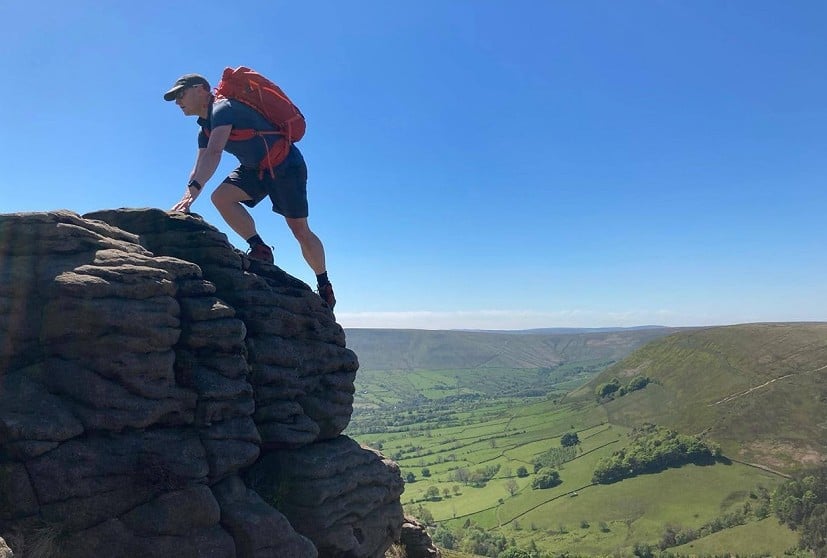
Weight and materials
According to Salewa the Apex Guide is made from "robust ROBIC®, a special, high-tenacity nylon that is 60% more tear-resistant than conventional nylon pack fabrics". Over a number of months of regular use, the pack has shown no sign of wear or damage beyond a few grubby marks. All the seams are neatly bound, the stitching neat and consistent with no breakages. All the components seem of equally good quality, be that buckles, zips or straps.
At 1252g (our scales, Salewa says 1210g) this definitely isn't the heaviest pack on test, and interestingly at least by stated volume the Apex Guide is the biggest pack here. On top of this, by stripping the lid and hip belt padding off and taking the back stiffener sheet and wire frame out, the weight drops to 843g which is rather light for what is probably still a 40 litre pack.
Fit and comfort
The Apex Guide appears to be only available in one back length and there isn't a female-specific version of this model. Salewa do make some women's-fit packs though so it's not as if they don't see a need for differing shapes between genders. At 175cm I'm probably quite close to what people think of as "average" for blokes, and the pack fits me well. Salewa's website says "Torso length: 45 - 53 cm", but the website gives no further advice on how you measure your torso to see if you are within this quite small sounding back length range (and we think measuring your own back at home is likely to be fairly approximate).
If the pack does fit you it is very comfortable, including when carrying heavy loads. The wire frame and stiffener-sheet do a good job of distributing the load, and while the waist belt is just a strap of 50mm webbing, Salewa have the clever design feature of removable hip-pads on the belt. I've found with these in place the hip belt definitely does help take a lot of the load, but because the padding is just over your hips, not the whole belt, when scrambling with the pack on, the waist belt does not feel slightly restrictive in the way bigger, padded hip belts, such as you get on backpacking rucksacks, often can.
The shoulder straps are a relatively novel split design, a feature of Salewa packs that we liked in a group test of smaller daypacks - see here. This makes them quite wide, but not restrictive when climbing because the two split sides of the strap can come closer together when you reach up and compress them. The split design also allows for some air flow through the strap, which must limit sweating to some degree.
On a related note Salewa have designed the back system to allow some airflow to get to your back and help keep things cool. Personally I seem to get a sweaty back even with the full "trampoline" style back systems, but I presume it must lower sweating levels a little. The only disadvantage I can see in this design is if the little slots in the back that allow air to flow turn out to catch blown snow when winter climbing, but not having had the chance to take the Apex Guide winter climbing because of the lockdown, I don't know this for sure.
Features
In short: nothing ridiculous but plenty of useful ones. The main body of the pack closes with a roll-top closure. This works well with the lid in place and is better for weather resistance than a drawcord if you are using the pack in its "fast and light" mode, minus the lid. Under the lid (or on top of the pack if you are using it lidless) is a rope holder/top-compression strap. There is a small security pocket sensibly placed at the top of the main body of pack, not your typical one on the inside of the lid. This means even when you don't use the lid, you've still got somewhere with a clip for your car keys.
There is a side zip that allows you to get into the main body of the pack without opening everything up top. This might be a potential leak - and failure - point, but so far no problem. I believe the zip used is a YKK water resistant one, so it should keep the worst of any rain out. Side zips on a day pack are a bit of a love/hate feature, but some users will appreciate having the option.
If you remove the lid of the pack, there are little 'slots', holes really, into the main body of the pack to tuck away the redundant straps and buckles that would normally hold the lid closed. This makes the pack look very neat when being used lidless, but I did also think they could potentially leak in very heavy rain. It's not been a problem so far in testing, and I think I'm happy to live with the risk for the flexibility of using the pack stripped down.
Ice tools attach securely in the modern way, and the elasticated fittings that hold them are also designed to hold walking poles if necessary. There are reinforced wide slots below the lower compression strap that along with the releasable upper compression strap means that any width of ski will be able to be carried. Indeed, as the "Guide" bit of the name hints, ski mountaineering is very much in this pack's remit. There is a flat and wide zip-accessed pocket on the front of the pack that takes a full size shovel blade and has slots to hold your shovel handle and avalanche probe. For those who don't ski-mountaineer, this pocket usefully holds things like waterproofs that you might want to grab or stow away without going into the main body of the pack.
Additionally, the Apex Guide has all the features you expect on a modern pack: a good haul loop/grab handle, a slot to allow a water bladder tube to pass out of the pack's main body, a little emergency whistle on the shoulder strap, even reflective print to maybe catch the eye of a driver as you walk down the road heading for the warms lights of the Clachaig and a well earned pint after a long day traversing a wintry Aonach Eagach.
The Apex Guide is a technical mountaineering pack designed for full days with dawn starts, steep approaches, and strenuous technical ascents and descents.
The Dry Back Contact carrying system lowers temperature at the central back and limits sweating thanks to its reduced contact area and also has a built-in micro-ventilation system with 3D air channels that lets greater airflow get to the back.
Made from robust ROBIC®, a special, high-tenacity nylon that is 60% more tear-resistant than conventional nylon pack fabrics, it can withstand just about everything from rocks to crampons and ice tools. It has a protective lid with a top pocket and an external safety pocket for your avalanche shovel and probe. For functional simplicity, the magnetic buckle system makes it possible to attach a rope single-handed. The roll top system allows easy volume adjustment to stabilize and centre the load. And the proven split shoulder strap system allows greater arm mobility, including with overhead moves.
Reviewed by Dan Bailey UKH 
A technical pack geared very much towards mountaineering, the Trion Nordwand 38 has a close and well-balanced fit for climbing, and a feature set suited to year-round use. It's a real lightweight, with a removable lid and hip padding for minimalist days. While the form-hugging back system is well-vented for warmer weather, there's not a lot of support if you're heavily laden, and since capacity is also a bit tighter than some, we'd say this pack is better for one-day hits than overnights. For what you're getting here, the price seems very reasonable. Not the most versatile model on review, but a good bet for lightweight climbing and scrambling days.
Weight and materials
Weighing 1005g all-in (our weight - there's none quoted on the Mammut website), the Trion Nordwand 38 is really quite light for a fully featured mountain pack of this size. By stripping off the lid and hipbelt padding you can reduce that to just 837g, and while that's not quite down in the 600-700g range of some similar sized alpine packs such as the ME Tupilak 37 or the Arc'teryx FL30, the difference won't seem huge to many users. Compared to some models, the lid is very easily removed, but the belt pad is a bit more of a fiddle to get off and back on.
The micro-ripstop Cordura fabric feels really durable for its weight, and it's an extra-burly version on the base and sides (the latter useful if you're carrying skis). It readily shrugs off moisture and snow. Overall build quality feels very good, and on the strength of our use so far I'd expect this pack to last well.
Fit and comfort
The Trion Nordwand 38 is available both for men, and in a women's-specific fit. With a slightly shorter back length than some models on review, even the men's version is unlikely to be an optimum fit for larger people. I'm 183cm/6 foot, with a fairly long back, and on me the hip belt sits a few centimetres too high to take much weight off the shoulders.
While I've used it as a crag pack, and on reasonably gear-intensive winter mountain days, the back system feels like it was designed more for lightness and flexiblity when climbing than serious donkey work. For carrying heavier loads, such as a rack and ropes or overnight bivvy gear, this is a less structured pack than some, and when laden its insubstantial 'Contact V' wire frame doesn't provide quite enough support, so the pack feels slightly saggy on the back. A Trion Nordwand 28 is also available, and the minimalist frame might make more sense with the lighter loads you'd probably carry in this smaller pack.
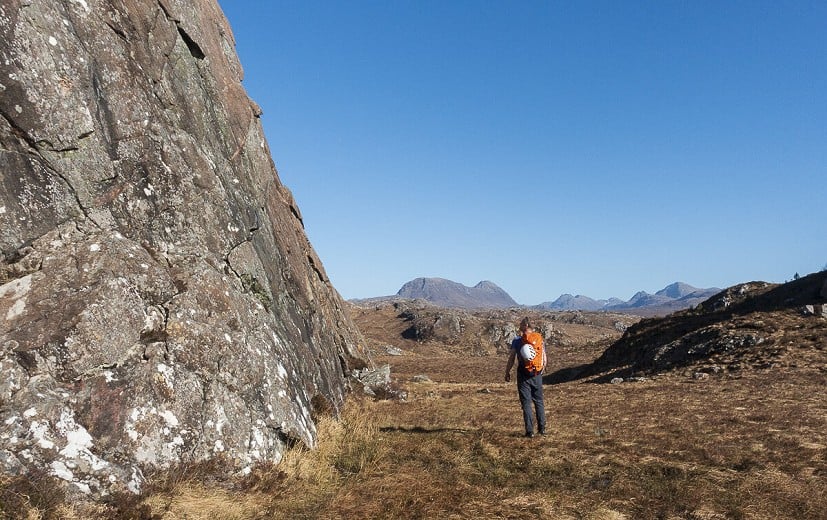
Whilst I'd say the frame is only so-so, I do find the shoulder straps and hipbelt a lot more successful. On a rucksack of this size there's sometimes a tendency to overdo the depth of padding, which can make things feel a bit spongy or even impede arm movement while climbing - but here the cushioning is firm and sensibly shallow. Cleverly, the straps are cushioned only over the shoulder, while the lower part is an open mesh, giving you a very cool, low-profile, body-hugging fit, while permitting completely free arm movement. In essence the fit of the straps looks and feels a bit like that of a running vest.
Assuming the pack suits your back length, the hipbelt fins are thin and flexible enough to give a good close fit around the middle, and if you didn't want to remove this pad then the belt is readily doubled around the body of the pack for climbing. There's more of that breathable mesh on the inside of the hip belt, and on the lumbar and back pads, so ventilation is good throughout, and for warm weather comfort the Trion Nordwand takes some beating.
It's worth noting the sternum strap - a length of elastic cord with sprung toggles, rather than the usual webbing-and-buckle arrangement. While this is adjustable for tightness, and can be set at various heights, the same can be said of a conventional chest strap, and I can't see any advantage in this slightly fussy setup. The disadvantage is clear as soon as the pack is heavily weighted, when you just don't feel as securely buckled into the harness as you should do if the shoulder straps were joined by a webbing strip.
Features
With a floating lid, the Trion Nordwand 38 can be over-stuffed to an extent, though some lids will go higher. Under the lid is a sturdy roll-top closure, and while this may be marginally more faff than a conventional drawcord, the advantage is that should you remove the lid to go minimalist, you still have a secure and weathertight seal at the top of the pack. The lid has a single buckle, with an extra-long strap that doubles as a rope holder if you're in lid-less mode (there doesn't seem to be a way of securing both a rope and the lid with this one buckle).
The usual zipped over-lid pocket is provided; this one is reasonably generous, but has a narrow opening that makes it a bit of a struggle to extract something wide like a map. Underneath is a zipped mesh security pocket. It's roomy, but I was nonplussed at first that it didn't have a key clip. Further investigation revealed a little side sleeve built into the body of the pack, which has both a water resistant zip and a key clip - the idea being that even lid-free Alpine minimalists need somewhere safe to keep their car keys (I know some folk favour wearing them on a string round the neck for ultimate security, but I've never resorted to this).
There's more storage on each shoulder strap, where you get a small stretchy running-style mesh pocket. These will hold a cereal bar or a 250ml soft bottle, and since both walkers and climbers will occasionally want to have such things to hand, these sleeves seem a thoughtful addition to your standard mountain pack features.
If carrying something bulky like a roll mat, the side straps have sufficient length, and they do a good job of compressing a half-full pack. They can also be doubled around the front of the pack, giving you a different way to reduce the volume. It's a small thing, but welcome, that Mammut have added elastic loops to neaten the spare tails of webbing, something all brands could easily do. Skiers will appreciate the sturdy ski-holding loops, but the rest of us might notice that they come at the expense of side wand sleeves. If you're walking (even if you're climbing) these can be a useful place to carry things like a bottle for quick access, and not adding them here does slightly compromise the Trion Nordwand's potential non-climbing versatility.
While the twin ice axe attachments are robust and secure, the lower clips can be a bit fiddly to use wearing thick gloves, and the upper velcro loops could conceivably get lost if accidentally unfastened when you remove your axes. You also get little loops to safely hold walking poles point down, which may be preferable to stashing them on the side of the pack point-up. A hydration sleeve and a sturdy haul loop complete a pretty comprehensive set of features.
On the ethical front, the Trion Nordwand has a PFC-free DWR treatment. Mammut also subscribe to the Fair Wear Foundation, an independent, non-profit organisation that works to improve conditions for workers in garment factories.
Trion Nordwand 38 - our versatile and robust alpine backpack from the Eiger Extreme Collection.
Extremely light and equally robust thanks to its high-quality Cordura material. Ideal for demanding alpine adventures.
The Trion Nordwand 38 has benefited from the experience and know-how of our top athletes, Dani Arnold, Nico Hojac and Stephan Siegrist, who were all significantly involved in the backpack's development.
rucksack

As a lightweight, midsized backpacking pack, the Muon really stands out for its functional design and its close and comfortable fit. Bring on summer bivvy trips, says Dan Bailey.
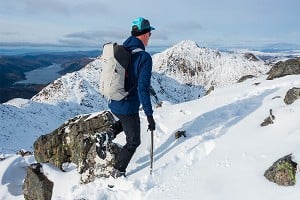
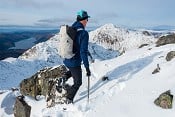
Built light but tough, this close-fitting and superbly functional little pack is spot on for minimalist climbing and mountaineering days, says Dan Bailey.
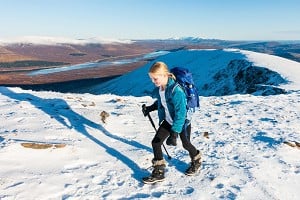

A grownup-standard backpacking pack, reduced in scale to fit a child's frame, the Fox has proved a huge hit with the junior review team. In this case great things definitely come in small packages.
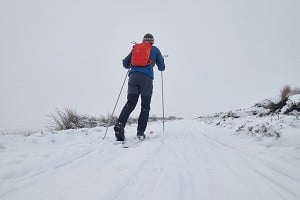
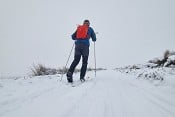
"You'd get the most out of this pack if you like keeping things fast, efficient, and minimalist. If you are inclined to...
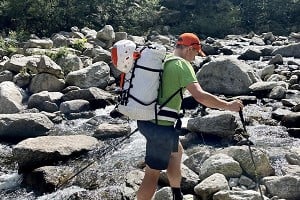

"Built To Send have created a surprisingly simple piece of equipment, but one made from the highest quality materials, and with a level...
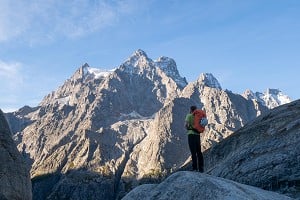
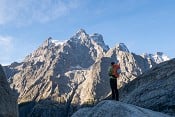
Aimed at those looking for a minimalist yet durable pack for mountain and alpine trips, the Core 35 prioritises functionality over unnecessary...
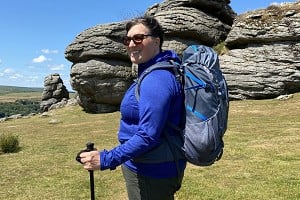

For walkers with larger bodies (including the 25% of women who are a size 18 or above), the arrival of the outdoor industry's first...


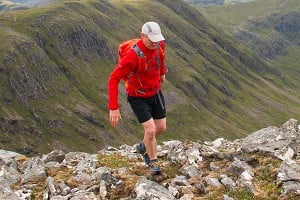

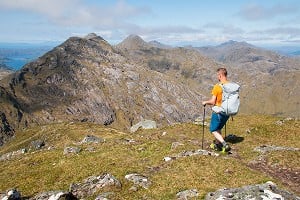
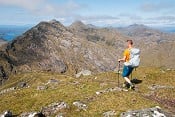
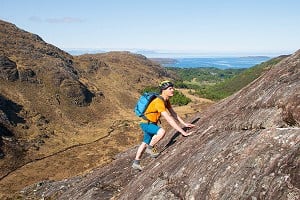
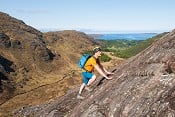

Comments
Thanks for the review, but it's a shame you haven't included any smaller British manufacturers, like Crux, Summiteer or Aiguille.
Agreed.
It's a fair question. The short answer is that we could never review every pack on the market; a line has to be drawn somewhere. This review was over six months in production, which represents a major investment in staff time. Adding more models would increase that workload, and time has to be paid for somehow. With that in mind, we have prioritised companies whose advertising helps support the site. Our door is open to any brand.
I don't think Crux manufacturers in this country. The owner of the company lives, or lived in France when I corresponded with him in the past.
There was a Crux pack in a previous group test, because I reviewed it, although oddly it would have fitted much better in this test as it's 40 ltr mountain pack not a backpacking one.
Crux is UK based again, but indeed makes most stuff in China (as with almost all manufacturers these days). The few exceptions being Aiguille Alpine and DMM, as far as I know.
Would be interested to hear if any of the other major brands don't do the bulk of their manufacturing in the far east...